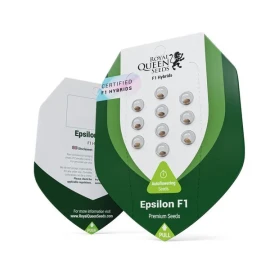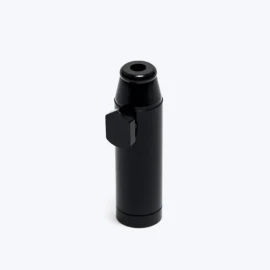Medusa F1
12,00 €
Experience the reliability and vigor of Royal Queen Seeds’ Medusa F1, a true F1 autoflower hybrid that combines the best traits of Sugar Magnolia and American Beauty genetics for consistent yields, balanced effects, and an exceptional mint-berry-diesel aroma profile.
Quick Facts
| Breeder: | Royal Queen Seeds |
| Genetics: | Sugar Magnolia × American Beauty (true F1 hybrid autoflower) |
| Type: | Autoflowering F1 hybrid (feminized) |
| Lifecycle: | 70–75 days seed to harvest |
| Height: | 80–85 cm (medium) |
| Indoor yield: | 401–500 g/m² |
| Outdoor yield: | 61–200 g/plant |
| THC: | 11–19% | CBD: <1% | CBG: notably high |
| Dominant terpenes: | Myrcene, Ocimene, Farnesene, Caryophyllene |
| Flavor/aroma: | Mint, pepper, fresh fruit, berries, diesel |
Introduction
Medusa F1 represents a breakthrough in autoflowering genetics, delivering the consistent vigor and stability that only true F1 hybrids can provide. This remarkable strain combines rapid 70-75 day cultivation cycles with robust yields and balanced effects that appeal to both recreational users seeking creative relaxation and medical users looking for reliable symptom management. Perfect for beginners who value predictable results and experienced growers who appreciate stable F1 performance, Medusa F1 offers an ideal entry point into premium autoflower cultivation with its forgiving nature and exceptional terpene complexity.
What is an F1 Hybrid?
F1 hybrids represent the first-generation cross between two distinct, stable parent lines, resulting in offspring that exhibit hybrid vigor—enhanced uniformity, accelerated growth rates, and increased robustness compared to their parents. This genetic phenomenon delivers remarkable consistency across phenotypes, meaning every Medusa F1 plant will display similar characteristics in growth pattern, flowering time, and cannabinoid production.
F1 autoflower hybrids are particularly noteworthy because they successfully combine the sophisticated genetics of photoperiod strains with the automated flowering characteristics inherited from ruderalis genetics. Unlike standard autoflowers that may show significant variation between plants, or traditional feminized photoperiod strains that require strict light schedule management, F1 autoflowers offer the best of both worlds: predictable performance with minimal environmental control requirements.
Key differences include:
- Stability: F1 genetics ensure consistent plant structure and cannabinoid profiles
- Vigor: Enhanced growth rates and stress resistance compared to standard autoflowers
- Uniformity: Minimal phenotype variation, ideal for consistent harvests
- Efficiency: Combines photoperiod quality with autoflower convenience
Genetics & Lineage
Medusa F1 emerges from the careful crossing of two exceptional parent strains: Sugar Magnolia and American Beauty. This genetic pairing was specifically chosen by Royal Queen Seeds to create a balanced hybrid that maximizes both aromatic complexity and therapeutic potential.
Sugar Magnolia contributes its renowned sweet, floral characteristics and uplifting cerebral effects. This parent line is known for its complex terpene profile that delivers fruity sweetness with subtle spicy undertones, along with moderate THC levels that promote creativity and social engagement without overwhelming sedation.
American Beauty brings robust growth characteristics and distinctive diesel aromatics to the cross. This parent strain is valued for its reliable flowering performance, disease resistance, and the ability to produce dense, resinous flowers with balanced cannabinoid ratios that appeal to both recreational and therapeutic users.
Royal Queen Seeds’ breeding objectives focused on creating a strain that would deliver consistent medium-height plants with reliable yield potential, while maintaining the aromatic complexity and balanced effects that make both parent strains distinctive. The resulting F1 hybrid achieves remarkable phenotype stability, meaning growers can expect minimal variation between plants in terms of structure, flowering time, and final cannabinoid content.
The F1 generation maintains high uniformity while occasionally expressing subtle variations in terpene intensity or flower density, though these differences remain within a narrow, predictable range that ensures consistent user experience across harvests.
Cannabinoids & Terpene Profile
Medusa F1’s cannabinoid profile reflects its carefully balanced genetics, with THC levels ranging from 11-19% depending on growing conditions and harvest timing. This moderate THC range provides noticeable psychoactive effects without the intensity that can overwhelm sensitive users, making it suitable for both experienced enthusiasts and those new to higher-potency varieties.
CBD content remains below 1%, placing Medusa F1 firmly in the recreational category while still allowing the entourage effect to influence the overall experience. Notably, this strain produces significant levels of CBG (cannabigerol), a cannabinoid gaining attention for its potential therapeutic properties and its role in modulating the effects of THC and other compounds.
Dominant Terpenes:
Myrcene serves as the foundation terpene, providing earthy, herbal base notes that promote physical relaxation and enhance the absorption of other cannabinoids. This terpene contributes to the strain’s calming body effects and helps create the balanced experience users appreciate.
Ocimene adds bright, fruity sweetness that elevates the overall aroma profile with citrusy, floral notes. This terpene also contributes to the uplifting mental effects and helps balance myrcene’s sedating tendencies.
Farnesene introduces subtle green apple and berry nuances that create complexity in both aroma and flavor. This terpene may contribute to the strain’s mood-enhancing properties and adds to the fresh fruit character that distinguishes Medusa F1.
Caryophyllene provides the distinctive spicy, peppery notes that complement the sweeter terpenes while potentially offering anti-inflammatory benefits. As the only terpene that can activate CB2 receptors, caryophyllene may enhance the strain’s therapeutic potential.
This terpene combination creates the signature mint-pepper-berry-diesel aroma profile while contributing to balanced effects that promote both mental clarity and physical relaxation.
Aroma & Taste
Medusa F1 delivers a sophisticated sensory experience that evolves from initial aroma through consumption to the lasting aftertaste. The primary scent profile opens with fresh mint and green pepper notes that immediately distinguish this strain from sweeter varieties. These crisp, almost cooling aromatics create an invigorating first impression that hints at the balanced effects to follow.
Secondary aromas emerge with closer inspection, revealing layers of fresh berries, tropical fruit sweetness, and subtle diesel undertones that add depth and complexity. The diesel notes provide an earthy foundation that prevents the fruit flavors from becoming overwhelming, while the berry sweetness softens the sharpness of the mint and pepper.
When consumed through smoking or vaporization, Medusa F1 produces a smooth inhale with prominent fruity flavors on the front palate, followed by the characteristic minty-spicy finish that lingers pleasantly. The smoke is generally well-tolerated, with the balanced terpene profile reducing harshness while maintaining flavor intensity.
For optimal terpene preservation and flavor expression, vaporization temperatures between 175-190°C (347-374°F) allow users to experience the full aromatic spectrum without degrading the more delicate compounds. Lower temperature vaporization emphasizes the fruity and minty notes, while higher temperatures bring forward the spicier, earthier characteristics.
Effects & Use Cases
Medusa F1 produces balanced effects that combine gentle physical relaxation with sustained mental clarity, making it suitable for various consumption scenarios throughout the day. Users typically report an initial uplift in mood and creativity, followed by a comfortable body relaxation that doesn’t impair functionality or focus.
Recreational Effects:
The moderate THC content produces noticeable psychoactive effects without overwhelming intensity. Users experience enhanced sociability, creative thinking, and a general sense of well-being that makes this strain excellent for social gatherings, creative projects, or relaxed evening activities. The balanced nature prevents the couch-lock associated with heavily indica-dominant strains while avoiding the anxiety that some users experience with high-THC sativas.
Potential Medical Applications:
Community reports suggest Medusa F1 may provide relief for various conditions, though individual responses vary significantly. Users have reported benefits for managing chronic pain, particularly when the discomfort interferes with daily activities but doesn’t require heavy sedation. The strain’s mood-lifting properties may help address stress, anxiety, and mild depression, while the physical relaxation can assist with muscle tension and sleep preparation when used in evening hours.
The notable CBG content may contribute to anti-inflammatory effects and digestive comfort, though research into CBG’s therapeutic applications remains in early stages. Some users report this strain helpful for maintaining appetite and reducing nausea.
Dosage & Timing Guidance:
New users should start with small amounts, particularly given the 11-19% THC range that can affect individuals differently. For daytime use, smaller doses tend to emphasize the creative and uplifting aspects while maintaining functionality. Evening consumption with larger amounts brings forward the relaxing properties that can facilitate rest and stress relief.
Common Side Effects:
Standard cannabis side effects apply, including dry mouth and dry eyes, which can be managed with adequate hydration. Some users may experience mild dizziness with higher doses, and sensitive individuals might notice increased anxiety if consuming amounts beyond their tolerance level. The moderate THC content generally makes these effects less pronounced than with higher-potency strains.
Medical Disclaimer: This information reflects community experiences and should not replace professional medical advice. Individuals using cannabis for medical purposes should consult healthcare providers, especially when combining with other medications or treatments.
Complete Cultivation Guide
Medusa F1’s 70-75 day lifecycle and compact 80-85 cm height make it ideal for various growing environments, from small indoor spaces to outdoor gardens. The F1 genetics provide enhanced disease resistance and environmental stability, though attention to humidity control and proper airflow remains important for optimal results.
Growing Medium Options
Soil Cultivation (Recommended for Beginners):
Organic soil provides the most forgiving growing environment for Medusa F1, with natural pH buffering and slower nutrient release that accommodates the plant’s moderate feeding requirements. High-quality potting soil mixed with perlite for drainage creates an ideal foundation. Soil cultivation typically produces the most complex terpene profiles, enhancing the strain’s distinctive mint-berry-diesel character.
Coco Coir (Intermediate):
Coco coir offers faster growth rates and improved root oxygenation while requiring more precise nutrient management. Monitor EC levels (1.2-1.6) and maintain pH between 5.8-6.2 for optimal nutrient uptake. Coco cultivation often produces slightly higher yields than soil while maintaining good terpene expression.
Hydroponics (Advanced):
Hydroponic systems can maximize Medusa F1’s yield potential, often reaching the upper end of the 401-500 g/m² range indoors. Requires precise control of pH (5.8-6.0), EC (1.0-1.4 vegetative, 1.4-1.8 flowering), and nutrient timing. Deep water culture and ebb-and-flow systems work particularly well with this strain’s root structure.
Lighting Requirements
Autoflowering strains don’t require light schedule changes to trigger flowering, allowing for consistent illumination throughout the lifecycle. Most successful growers use 18/6 or 20/4 light schedules, balancing growth promotion with energy efficiency.
Indoor Lighting:
LED lights provide the best combination of energy efficiency and spectrum control for Medusa F1. Provide 35-50 watts per square foot of quality LED lighting, maintaining 18-24 inches distance during early growth and adjusting based on plant response. Full-spectrum LEDs that include UV and far-red wavelengths can enhance terpene production and overall plant development.
Light Schedule Options:
- 18/6: Most popular choice, providing strong growth while allowing plants rest period
- 20/4: Faster growth with minimal increase in energy costs
- 24/0: Maximum growth speed but highest energy consumption and potential for light stress
Environmental Control
Temperature Management:
Maintain daytime temperatures between 20-26°C (68-79°F) throughout the lifecycle. Night temperatures can drop 5-7°C without negative effects. Avoid exceeding 28°C (82°F) during flowering as higher temperatures can degrade terpenes and reduce potency.
Humidity Control:
Seedling/Early Vegetative: 60-70% RH supports healthy establishment
Late Vegetative: 50-60% RH promotes strong growth
Early Flowering: 45-55% RH prevents mold while maintaining healthy development
Late Flowering: 40-45% RH essential for preventing bud rot in dense flowers
Air Circulation:
Install oscillating fans to maintain gentle, constant airflow throughout the growing space. Avoid creating wind burn by ensuring air movement is gentle but persistent. Proper airflow prevents stagnant air pockets that can harbor pathogens and ensures even CO2 distribution.
Container Selection and Spacing
Pot Size:
7-15 liter containers provide optimal root development for Medusa F1’s medium stature. Smaller containers (7-10L) work well in space-limited environments, while larger containers (12-15L) can maximize yield potential. Fabric pots promote better root health through improved oxygenation.
Plant Spacing:
Allow 30-50 cm between plants to ensure adequate light penetration and air circulation. Closer spacing works in controlled environments with excellent airflow, while outdoor growing benefits from wider spacing to prevent moisture retention and disease pressure.
Nutrient Management
Medusa F1’s F1 vigor means it responds well to moderate feeding schedules without requiring heavy nutrient applications that can lead to toxicity or reduced terpene production.
Vegetative Stage (Weeks 1-4):
Begin with quarter-strength nutrients and gradually increase to half-strength by week 3. Focus on nitrogen-rich formulations while maintaining adequate phosphorus and potassium. Cal-mag supplementation proves beneficial, especially in coco and hydroponic systems.
Flowering Stage (Weeks 5-10):
Transition to bloom-focused nutrients with reduced nitrogen and increased phosphorus and potassium. Maintain micronutrient supplementation throughout flowering to support terpene production and overall plant health.
Feeding Schedule:
Feed every other watering in soil, or daily with reduced concentration in coco/hydro systems. Monitor plant response and adjust accordingly—Medusa F1 typically prefers consistent, moderate feeding over heavy applications.
Training Techniques
Low-Stress Training (LST):
Begin gentle LST during week 2-3 by bending main stems horizontally and securing with soft ties. This technique increases light exposure to lower branches without shocking the plant, often increasing yields by 20-40%.
Selective Defoliation:
Remove only large fan leaves that block light to developing bud sites. Perform defoliation gradually over several days rather than all at once. Focus on interior leaves that receive no direct light while preserving healthy, light-exposed foliage.
Topping Considerations:
While possible, topping autoflowers requires careful timing and plant health assessment. If attempting, top only once during early vegetative stage (week 2-3) and only on vigorous, healthy plants.
Pest and Disease Prevention
Integrated Pest Management:
Install yellow sticky traps to monitor for flying pests and implement preventive measures before problems develop. Regular visual inspection of leaf undersides and growing tips helps catch issues early.
Common Pest Prevention:
Neem oil applications during vegetative stage can prevent many pest issues. Beneficial insects like predatory mites provide ongoing protection. Maintain clean growing environment and quarantine new plants before introduction.
Disease Prevention:
Proper environmental control prevents most disease issues. Ensure adequate spacing, maintain appropriate humidity levels, and provide consistent airflow. Remove any yellowing or damaged plant material promptly to prevent pathogen establishment.
Harvest Timing and Processing
Harvest Window:
Monitor trichomes with a jeweler’s loupe or digital microscope starting around day 65. Harvest when trichomes are predominantly milky white with 10-20% amber for balanced effects. Earlier harvest (mostly clear to milky) emphasizes cerebral effects, while later harvest (more amber) increases sedating properties.
Drying Process:
Hang whole plants or individual branches in a dark environment maintained at 45-55% humidity and 18-21°C temperature. Proper drying takes 7-10 days and preserves terpene content while preventing mold development.
Curing Protocol:
Transfer properly dried buds to airtight containers, filling to 75% capacity. Store at 60-65% humidity using humidity packs if necessary. Open containers daily for first week, then every few days for 2-6 weeks. Proper curing enhances flavor, smoothness, and potency.
Troubleshooting Common Issues
Bud Rot/Botrytis Prevention and Treatment
Symptoms: Brown, mushy areas within flower clusters, often with visible gray mold
Causes: High humidity (>60%) during flowering, poor airflow, dense buds retaining moisture
Prevention: Maintain humidity below 50% during flowering, ensure constant air movement, provide adequate plant spacing
Treatment: Immediately remove affected areas with sterilized tools, increase airflow, reduce humidity to 40-45%, consider fungicide application if problem persists
Nutrient Burn Management
Symptoms: Brown, crispy leaf tips progressing inward, leaf curling, overall plant stress
Causes: Excessive nutrient concentration, pH imbalance preventing proper uptake
Prevention: Start with half-strength nutrients, monitor EC/PPM levels, maintain proper pH ranges
Treatment: Flush growing medium with pH-adjusted water, reduce nutrient concentration by 25-50%, allow plant to recover before resuming feeding
Growth and Development Issues
Slow Growth/Stunting:
Often caused by root binding, inadequate lighting, temperature stress, or overwatering. Check root health, ensure adequate container size, verify light intensity and schedule, maintain proper watering frequency.
Stretching/Elongation:
Usually indicates insufficient light intensity or excessive temperatures. Reduce light distance, increase intensity, or improve environmental control. Some stretch is normal during early flowering.
Yellowing Leaves:
Natural senescence during late flowering is normal and expected. Early yellowing may indicate nutrient deficiency, pH problems, or root issues. Assess timing, check pH levels, and adjust feeding accordingly.
Environmental Stress Response
Heat Stress:
Manifests as leaf curling, wilting despite adequate water, and reduced growth. Improve ventilation, reduce temperatures, ensure adequate water supply, and consider adjusting light intensity.
Light Burn:
Bleaching of upper leaves and buds, often with crispy texture. Increase light distance, reduce intensity, or improve heat dissipation around lighting fixtures.
Comparison Analysis
F1 Hybrid Advantages vs Traditional Autoflowers
Stability: Medusa F1’s true F1 genetics provide significantly more consistent plant structure, flowering time, and cannabinoid production compared to standard autoflowers that may show substantial phenotype variation.
Vigor: Enhanced growth rates and stress resistance make Medusa F1 more forgiving for new growers while providing experienced cultivators with predictable results for commercial or personal production.
Yield Consistency: While traditional autoflowers might range from 200-600 g/m² depending on phenotype, Medusa F1 consistently produces within the 401-500 g/m² range under proper conditions.
Competitive Positioning
Lifecycle Speed: At 70-75 days, Medusa F1 falls within the faster range of quality autoflowers, comparing favorably to strains requiring 8-12 weeks for completion.
Height Management: The consistent 80-85 cm height makes space planning more reliable than strains with variable height expression.
Aroma Profile: The distinctive mint-berry-diesel combination differentiates Medusa F1 from the sweeter fruit profiles or stronger skunk aromatics common in the autoflower market.
THC Range: The 11-19% THC range appeals to users seeking noticeable effects without overwhelming potency, positioning it well for both recreational and therapeutic applications.
Ideal User Profiles
Perfect for Beginning Growers
Medusa F1’s stable genetics and forgiving nature make it an excellent choice for cultivators developing their skills. The predictable growth pattern, moderate nutrient requirements, and consistent flowering timeline reduce the variables that can overwhelm new growers. F1 vigor means plants recover well from minor mistakes in watering, feeding, or environmental control.
Excellent for Space-Limited Cultivation
The consistent 80-85 cm height and compact structure make Medusa F1 ideal for grow tents, closets, or other restricted spaces. Plants remain manageable without extensive training while still producing substantial yields relative to their size.
Suited for Terpene Enthusiasts
The complex mint-berry-diesel aroma profile appeals to users who appreciate sophisticated flavors and aromatics. The balanced terpene profile provides a unique sensory experience that distinguishes Medusa F1 from single-note varieties.
Balanced Effects for Diverse Users
The moderate THC range and balanced effects make this strain suitable for both recreational users seeking creative relaxation and medical users requiring symptom management without impairment. The presence of CBG adds potential therapeutic value for users exploring cannabinoid diversity.
Not Ideal For
High-THC Seekers: Users requiring potency above 20% THC should consider other options, though the balanced cannabinoid profile may provide satisfying effects despite moderate THC levels.
Commercial Scale Operations: While yields are respectable, growers focused purely on maximum production might prefer strains with higher yield potential, though they may sacrifice the consistency and quality that F1 genetics provide.
Seed Sourcing and Authentication
Purchasing from Authorized Sources
Ensure authenticity by purchasing Medusa F1 seeds exclusively from Royal Queen Seeds’ authorized retailers. Authentic packaging includes official branding, holographic security features, batch numbers, and proper labeling with genetic information and growing guidelines.
Authenticity Verification
Genuine Medusa F1 seeds display consistent size and coloration typical of Royal Queen Seeds’ quality standards. Packaging should include QR codes or verification methods that link to official Royal Queen Seeds databases for authentication confirmation.
Storage and Viability
Store seeds in cool, dark, dry conditions to maintain viability. Refrigerator storage in airtight containers can preserve germination rates for several years. Avoid freezing, which can damage seed structure and reduce germination success.
Quality Indicators
Fresh, viable seeds appear dark brown to black with tiger-stripe patterns. Avoid seeds that appear green, white, or cracked, as these typically indicate immaturity or damage that affects germination rates and plant vigor.
Legal Considerations and Safety
Regulatory Compliance
Cannabis laws vary significantly by jurisdiction. Research local and regional regulations regarding cultivation, possession, and consumption before purchasing or growing Medusa F1. Many areas require licenses for cultivation or limit plant numbers and possession amounts.
Safety Protocols
Store all cannabis products securely away from children and pets. Use appropriate safety equipment during cultivation, including proper ventilation for indoor growing and protective equipment when handling nutrients or plant treatments.
Medical Use Considerations
While community reports suggest various therapeutic applications, individual responses to cannabis vary significantly. Consult healthcare providers when using cannabis for medical purposes, especially when combining with other medications or treatments for serious health conditions.
Responsible Consumption
Start with small amounts to assess individual tolerance and response. Avoid driving or operating machinery while under the influence. Be aware that effects can last several hours and may impair judgment and coordination.
Frequently Asked Questions
How long does Medusa F1 take from seed to harvest?
Medusa F1 completes its lifecycle in 70-75 days under optimal conditions, making it one of the faster quality autoflowers available.
What yields can I expect from Medusa F1?
Indoor cultivation typically produces 401-500 g/m² under proper conditions, while outdoor yields range from 61-200 g per plant depending on environmental factors and container size.
Is Medusa F1 suitable for beginning growers?
Yes, the stable F1 genetics provide enhanced vigor and forgiveness that makes this strain excellent for developing cultivation skills while still producing quality results.
How strong is the aroma during flowering?
Medusa F1 produces a medium to strong aroma featuring mint, berries, and diesel notes. Indoor growers should plan for carbon filtration and proper ventilation to manage odor.
Are Medusa F1 seeds feminized?
Yes, Medusa F1 is sold as a feminized autoflowering strain, meaning plants will be female and flower automatically without light schedule changes.
What is the THC potency of Medusa F1?
THC levels typically range from 11-19% depending on growing conditions and harvest timing, with CBD below 1% and notable CBG presence.
Does Medusa F1 require special drying or curing?
Standard drying and curing protocols work well: 7-10 days drying at 45-55% humidity, followed by 2-6 weeks curing in airtight containers for optimal flavor and potency development.
Can I grow Medusa F1 outdoors?
Yes, Medusa F1 performs well outdoors in suitable climates, though yields may vary based on local conditions, season timing, and container size.
What growing medium works best for Medusa F1?
All growing media work well, though soil provides the most forgiving environment for beginners while hydroponic systems can maximize yield potential for experienced growers.
How does F1 genetics benefit this strain?
F1 genetics provide enhanced uniformity, vigor, and stability compared to standard autoflowers, resulting in more predictable growth patterns, flowering times, and cannabinoid production across all plants.
Related Products
Frequently Asked Questions
Everything You Need to Know















